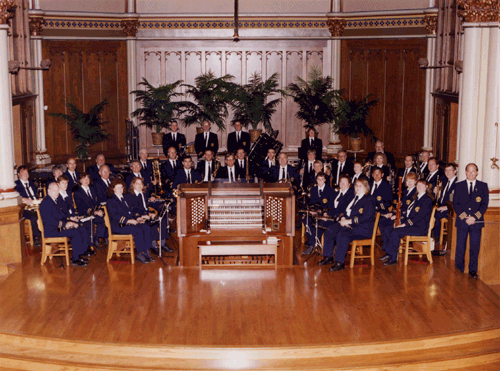
OUR HISTORY
In 1855 fourteen young musicians signed a constitution, collected a treasury of $123.04, and appointed Frederick T. Iobst of Emmaus, Pennsylvania as their director. The "Millerstown Brass Band," consisting only of brass instruments and drums, became the forefather of today's Macungie Band. Recent research by the Macungie Historical Society points to an even earlier band in the community as early as 1828. Either way, the Macungie Band is one of the oldest civilian concert bands in the nation.
Frederick T. Iobst was succeeded by Professor John Hook of Reading. The third director of the Millerstown Brass Band was Frederick Rudolph Benkhardt of Allentown who is buried in Allentown Union-West Cemetery. George Douglass, a leading member of Beck’s Famous Band of Philadelphia followed aa the fourth director.
In 1861, Peter J. Weiler, one of the original band members assumed the responsibilities of Director. Under his direction the band gained a renowned reputation. He had an ear for music that enabled him to rewrite the scores of tunes by memory. Mr. Weiler continued as director for more than 40 years until his death in 1906.
At the start of the Civil War, the "Millerstown Brass Band" (as it was known at the time) volunteered as an entire unit. In early November of 1861, the band began its ninety day tour of duty as the 54th Regiment Band, Pennsylvania Volunteers. They served as guards and sentries on the railroad tracks at Berkley Springs, Virginia. At the completion of their duty most of the bandsmen returned home, but a few enlisted and saw combat later in the war.
In 1875, Millerstown residents renamed their borough "Macungie", which is American Indian for "Bear Swamp" or "Bear's Feeding Place". Accordingly, the band also changed its title and became known from then on as the Macungie Band. By then, woodwind and reed instruments had been added to the band.
The early 20th century marked a dormant period for the band. However, in 1914 under the leadership of Howard Haas, the Macungie Band reorganized, formulated a new charter, and elected J. Walter Singmaster as its first president. Three years later, on April 27, 1917, the band held its first concert.

The Macungie Band in 1925 with Director John B. Meyers

Successive directors following Howard Haas included John B. Meyers (1923 to 1928) (father of Albertus Meyers, Sousa Band Alumnus and long-time conductor of the Allentown Band); Ray G. Wetherhold (1928 to 1933) (a composer of great note); Frank Shingler (1933 to 1937); and Ralph Daubert from 1937 until his death in 1973. They were followed by Gerald Shingler (1973 to 1982); Craig Paine (1982 to 1984); and Macungie native Douglas Bolasky (1984 to 2009) (2nd longest); and our present director, Michael Moran.
A major highlight in the band's history occurred in 1949 when the Macungie Memorial Park acquired a bandshell for outdoor concerts. This came about by means of citizens' support.
The Macungie Band celebrated its 150th anniversary in 2005. While other small town bands have dissolved their charters, the Macungie Band proudly continues as one of a shrinking number of town bands in America.
